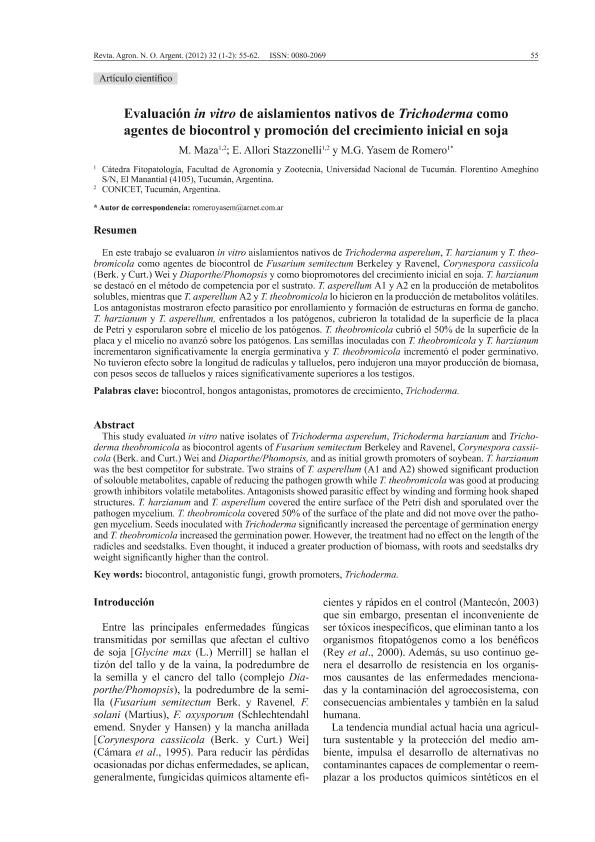Artículo
En este trabajo se evaluaron in vitro aislamientos nativos de Trichoderma asperelum, T. harzianum y T. theobromicola como agentes de biocontrol de Fusarium semitectum Berkeley y Ravenel, Corynespora cassiicola (Berk. y Curt.) Wei y iaporthe/Phomopsis y como biopromotores del crecimiento inicial en soja. T. harzianum se destacó en el método de competencia por el sustrato. T. asperellum A1 y A2 en la producción de metabolitos solubles, mientras que T. asperellum A2 y T. theobromicola lo hicieron en la producción de metabolitos volátiles. Los antagonistas mostraron efecto parasítico por enrollamiento y formación de estructuras en forma de gancho. T. harzianum y T. asperellum, enfrentados a los patógenos, cubrieron la totalidad de la superficie de la placa de Petri y esporularon sobre el micelio de los patógenos. T. theobromicola cubrió el 50% de la superficie de la placa y el micelio no avanzó sobre los patógenos. Las semillas inoculadas con T. theobromicola y T. harzianum incrementaron significativamente la energía germinativa y T. theobromicola incrementó el poder germinativo. No tuvieron efecto sobre la longitud de radículas y talluelos, pero indujeron una mayor producción de biomasa, con pesos secos de talluelos y raices significativamente superiores a los testigos. This study evaluated in vitro native isolates of Trichoderma asperelum, Trichoderma harzianum and Trichoderma theobromicola as biocontrol agents of Fusarium semitectum Berkeley and Ravenel, Corynespora cassiicola (Berk. and Curt.) Wei and Diaporthe/Phomopsis, and as initial growth promoters of soybean. T. harzianum was the best competitor for substrate. Two strains of T. asperellum (A1 and A2) showed significant production of solouble metabolites, capable of reducing the pathogen growth while T. theobromicola was good at producing growth inhibitors volatile metabolites. Antagonists showed parasitic effect by winding and forming hook shaped structures. T. harzianum and T. asperellum covered the entire surface of the Petri dish and sporulated over the pathogen mycelium. T. theobromicola covered 50% of the surface of the plate and did not move over the pathogen mycelium. Seeds inoculated with Trichoderma significantly increased the percentage of germination energy and T. theobromicola increased the germination power. However, the treatment had no effect on the length of the radicles and seedstalks. Even thought, it induced a greater production of biomass, with roots and seedstalks dry weight significantly higher than the control.
Evaluación in vitro de aislamientos nativos de Trichoderma como agentes de biocontrol y promoción del crecimiento inicial en soja
Título:
This study evaluated in vitro native isolates of Trichoderma as biocontrol agents of an initial growth promoters of soybean.
Fecha de publicación:
12/2012
Editorial:
Universidad Nacional de Tucumán. Facultad de Agronomía y Zootecnia
Revista:
Revista Agronómica del Noroeste Argentino
ISSN:
0080-2069
Idioma:
Español
Tipo de recurso:
Artículo publicado
Clasificación temática:
Resumen
Palabras clave:
Crecimiento
,
Soja
,
Trichoderma
,
Biocontrol
Archivos asociados
Licencia
Identificadores
Colecciones
Articulos(CCT - NOA SUR)
Articulos de CTRO.CIENTIFICO TECNOL.CONICET - NOA SUR
Articulos de CTRO.CIENTIFICO TECNOL.CONICET - NOA SUR
Citación
Maza, Marianela; Stazornelli, Enzo Allori; Yasem, Marta Graciela; Evaluación in vitro de aislamientos nativos de Trichoderma como agentes de biocontrol y promoción del crecimiento inicial en soja; Universidad Nacional de Tucumán. Facultad de Agronomía y Zootecnia; Revista Agronómica del Noroeste Argentino; 32; 1-2; 12-2012; 55-62
Compartir




